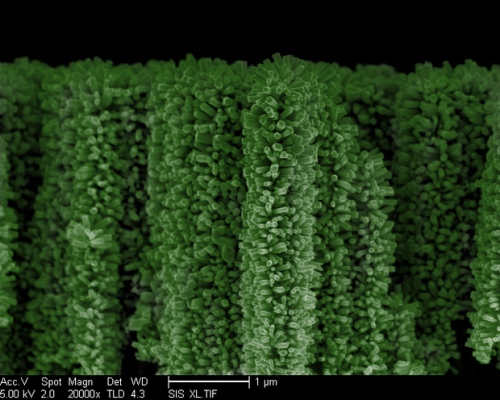A research team at the University of California, San Diego is creating a forest of nanowire trees to cleanly harvest more amount of solar energy for generating hydrogen fuel efficiently without utilizing fossil fuels.
 This is an electronic microscopic image of a nanoforest, or "3-D branched nanowire array." (Green tint added for contrast.) (Image Credit: Wang Research Group, UC San Diego Jacobs School of Engineering.)
This is an electronic microscopic image of a nanoforest, or "3-D branched nanowire array." (Green tint added for contrast.) (Image Credit: Wang Research Group, UC San Diego Jacobs School of Engineering.)
According to the team, nanowires made of ubiquitous materials such as zinc oxide and silicon can be used as a low-cost source for generating hydrogen fuel on a large scale. The study findings have been published in the journal, Nanoscale.
Deli Wang, one of the researchers, explained that vertical structure and branches of the nanowire trees are vital for harvesting more amount of solar energy because light is grabbed and adsorbed by the vertical structure, while it is reflected by the flat surfaces.
The research team imitated this nanostructure in its ‘3D branched nanowire array,’ which utilizes photoelectrochemical water-splitting process to generate hydrogen gas without any green-house gas as a byproduct.
Ke Sun, another researcher, informed that the vertical nanotree structure also improves the output of hydrogen gas by extracting very tiny hydrogen gas bubbles rapidly. In addition, the vertical branch structure has increased the surface area by at least 400,000 folds for chemical reactions.
The research team’s next step is artificial photosynthesis wherein sunlight is absorbed by plants, which also gather water and carbon dioxide from the surroundings to produce carbohydrates to drive their own growth. The team plans to imitate this process to harvest carbon dioxide from the surroundings in order to decrease carbon emissions and produce hydrogen fuel from it.